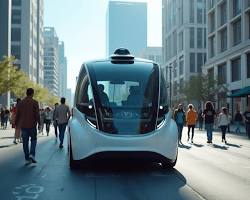The advent of robotaxis, self-driving taxis, is revolutionizing urban mobility. These autonomous vehicles promise reduced traffic congestion, enhanced safety, and greater convenience. However, gaining public trust remains a significant challenge for widespread adoption. This article explores how robotaxi companies are addressing skepticism and earning passengers’ confidence through transparency, safety measures, and user-focused strategies.
The Role of Transparency in Building Trust
Transparency is crucial in demystifying how robotaxis operate and fostering trust among passengers. Companies are adopting several strategies to educate the public:
- Open Events and Demonstrations: Firms host events and provide virtual demonstrations to explain the technologies powering autonomous vehicles, such as LiDAR, machine learning, and safety redundancies.
- Detailed Safety Protocols: Sharing safety procedures reassures users that these vehicles prioritize passenger well-being.
By simplifying complex concepts and showcasing their reliability, robotaxi developers aim to make the technology accessible and trustworthy.
Rigorous Safety Standards: The Cornerstone of Trust
Safety is at the heart of passenger confidence. Companies like Waymo and Cruise have conducted millions of miles of testing in both controlled and real-world conditions. Key steps include:
- Publicizing Data: Sharing crash reports and disengagement statistics (when human drivers intervene) to demonstrate progress in safety.
- Controlled Testing: Testing in various scenarios ensures systems can handle complex environments.
These efforts emphasize that robotaxis are designed to reduce human error, a leading cause of accidents.
Enhancing Passenger Communication
Clear communication during a ride is critical to easing anxiety. Robotaxis use advanced features to keep passengers informed:
- In-Vehicle Displays: Real-time maps, route updates, and traffic conditions are displayed on screens.
- Audio Cues: Voice assistants provide updates on actions like slowing down for pedestrians or making a turn.
By ensuring passengers are aware of the vehicle’s actions, companies foster a sense of safety and control.

Addressing Ethical and Privacy Concerns
Robotaxis face ethical dilemmas and data privacy challenges. Companies are tackling these issues head-on:
- Ethical Decision-Making: Collaborating with ethicists and policymakers to create frameworks for ambiguous scenarios, such as unavoidable accidents.
- Data Protection: Implementing robust cybersecurity measures and complying with privacy regulations like GDPR and CCPA.
By being transparent about ethical principles and data protection practices, robotaxi developers are building trust with a tech-savvy audience.
Accessibility: A Key Selling Point
Robotaxis aim to revolutionize mobility for individuals who cannot drive, such as those with disabilities. Companies highlight features like:
- Wheelchair Accessibility: Ensuring inclusivity for all users.
- Voice-Activated Controls: Assisting visually impaired passengers.
By promoting accessibility, robotaxi services position themselves as a transformative solution for a broader audience.
Effective Marketing and Storytelling
Humanizing autonomous technology through storytelling helps build trust:
- Testimonials: Sharing real-life experiences of passengers who benefited from robotaxis.
- Social Media Campaigns: Highlighting stories like safe rides for seniors or improved mobility for late-night workers.
Such narratives establish an emotional connection with potential users, making the technology less intimidating.
Regulation and Collaboration with Authorities
Governments play a pivotal role in ensuring robotaxi safety and reliability. Companies collaborate with regulators to:
- Establish Clear Rules: Meeting stringent safety and performance standards.
- Publicize Testing Data: Showcasing transparency in operations.
Partnerships with local authorities further legitimize robotaxi services and address regional concerns.
Advanced User-Friendly Features in Robotaxis
To improve the passenger experience, robotaxi developers focus on user-friendly technology:
- Intuitive Interfaces: Booking, navigating, and tracking rides through seamless apps.
- Comfortable Cabins: Spacious designs, climate control, and entertainment systems for a pleasant journey.
These features ensure passengers feel confident and at ease during their rides.
Reducing Accidents Through Technology (Robotaxis)
Robotaxis are designed to mitigate human error, the leading cause of accidents. By using advanced technologies, such as:
- LIDAR and Radar: Detecting objects and responding rapidly to hazards.
- Vehicle-to-Vehicle Communication: Sharing data about road conditions and traffic patterns for safer networks.
These advancements position robotaxis as a safer alternative to traditional vehicles.
Real-Time Support and Transparency of Robotaxis
Providing real-time customer support builds trust by addressing passenger concerns promptly. Features include:
- Immediate Assistance: Allowing passengers to report issues or seek help during rides.
- Transparency About Incidents: Companies openly disclose malfunctions or accidents, detailing corrective actions.
This proactive approach ensures passengers feel supported and informed.
The Road Ahead for Robotaxis
Earning passenger trust is an ongoing journey that requires innovation, transparency, and a commitment to ethical practices. As robotaxis continue to demonstrate safety, accessibility, and reliability, public perception is likely to shift.
By addressing concerns proactively and showcasing the benefits of autonomous technology, robotaxis are paving the way for a future where urban mobility is safer, more efficient, and universally accepted.
For more interesting content, check out our blog: https://techvibezonline.com


